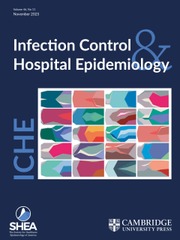Dear Editor,
Barreto et al Reference Barreto, Jerry and García1 provide important early evidence that virtual reality (VR) can be harnessed to strengthen training for cleaning and disinfection of portable medical equipment (PME). Their pilot demonstrates feasibility and user acceptability, but the crucial question remains: how do we translate immersive learning into measurable improvements in infection prevention and control (IPC)?
First, on outcomes beyond satisfaction. The study highlights favorable perceptions of VR but does not yet demonstrate translation into practice. Evidence from personal protective equipment training trials shows that VR can improve procedural accuracy and reduce error rates under simulated conditions. Reference Tsukada, Yasui and Miyata2 Extending this paradigm, PME-focused VR training should be evaluated against concrete infection outcomes—such as reductions in residual bioburden (via fluorescent marker assays or ATP bioluminescence) and downstream healthcare-associated infection (HAI) incidence. Without linking to these metrics, VR risks being adopted as a novelty rather than a validated IPC intervention.
Second, on cost-effectiveness and scalability. A key barrier identified by Barreto et al Reference Barreto, Jerry and García1 is technical usability. Equally pressing is the economic challenge. Full VR rigs are expensive and may be unrealistic for facilities with limited resources, precisely those where PME contamination is most consequential. Reference Sansom, Gussin and Schoeny3 Mobile-based augmented reality (AR) modules, which have demonstrated feasibility in hand hygiene training, Reference Gasteiger, van der Veer, Wilson and Dowding4 may offer a scalable hybrid model: immersive, context-sensitive, but cost-contained. Rigorous economic evaluations comparing VR, AR, and conventional simulation will be critical for decision-makers.
Third, on sustainability and integration. IPC training is not a one-time event but a continuous competency process. Embedding VR into mandatory training cycles, with periodic content updates aligned to evolving Centers for Disease Control and Prevention (United States) and World Health Organization (a specialized agency of the United Nations) guidelines, would ensure currency and institutional buy-in. Importantly, scenarios must be culturally and contextually adapted—reflecting the types of PME, workflow patterns, and infection risks most salient in different regions. Reference Kouijzer, Kip, Bouman and Kelders5 This localization could prevent the common pitfall of “one-size-fits-all” digital interventions.
Finally, on research priorities. Future investigations should move beyond pilot usability to randomized and pragmatic trials. Key design features include:
-
longitudinal follow-up to assess retention of cleaning skills,
-
objective contamination measures pre- and post-training,
-
stratification by professional role and experience, and
-
cost-per-outcome analyses to benchmark against existing IPC education.
Such studies would help determine whether VR should remain an adjunct tool for high-resource centers or evolve into a global standard for PME disinfection training.
In conclusion, Barreto et al Reference Barreto, Jerry and García1 set the stage for innovation in IPC education. The next frontier is demonstrating that VR training produces sustained, cost-effective, and equitable reductions in contamination and HAIs. Only then can immersive technologies transition from promising pilots to essential components of an infection prevention strategy.
Data availability statement
No new data generated.
Financial support
None.
Competing interests
The authors declare no conflicts of interest.
AI usage statement
ChatGPT was used only for language polishing and editing. No data analysis or scientific conclusions were generated by AI, and the authors take full responsibility for the content.


